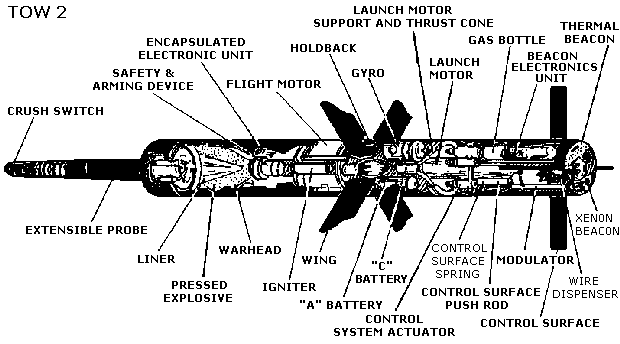The life span of the TOW missile is extremely short in our normal time span
(approximately 24 seconds), but it is an eternity when you are sitting in the front
cockpit guiding the TOW to its target while in the heat of battle. The following
information should give you a better understanding of how a TOW missile comes to life.
Gingerly the pilot unmasks the helicopter. The gunner has spotted the target and now
switches from two power magnification on the TSU to 13 power. With slight pressure
application on the joystick the gunner brings the TSU crosshairs unto the target. The
pilot brings the aircraft to prelaunch constraint. The attack flag in the TSU pops on. The
gunner squeeze the trigger on the left handgrip. Now the missile is born.
| T -1.52 seconds |
When the trigger is pulled, three batteries are activated that provide
power to the electronics, the Xenon or thermal beacon and the actuator subsystem. The
attitude control gyro spins up to 42,000 rpm. Electronic signals are balance between the
Missile Command Amplifier and the missile. |
| T = 0.0 seconds |
The launch motor ignites producing 15,000 lbs. of thrust for 0.35 to 0.50
seconds. This causes the missile to accelerate to 250 ft/sec. The launch motor is
completely expended before the missile exits the tube. The wings on the missile extend as
it exits the tube and completes the circuit to activate the flight motor, which occurs
about 7 meters from the launcher |
| T + 0.5 |
TOW missile launcher stows |
| 30 - 65 meters |
Warhead arms by acceleration G forces |
| Upon capture, the TOW missile becomes a
closed-loop system. The Xenon beacon and thermal beacon ( TOW 2, TOW2A ) are
installed in the rear of the missiles and are detected by the Xenon detector or thermal
tracker in the TSU. Two wire dispensers are mounted on the rear of the missile at 90 and
270 degree positions. These dispensers contain 3,750 meters of single strand wire. Control
surface flippers respond to signals from this wire command link. Helium powers the control
actuators. The attitude gyro, which limits yaw and roll, is driven by nitrogen |
| T + 1.35 sec./ approximately 230 meters |
The IR sensors in the TSU switches from wide field of view (FOV) (+ 6
degrees) to medium FOV (+ 1.5 degrees). |
| T + 1.6sec./ approximately 350 meters |
The flight motor burns out. Missile velocity is approximately 1,080 ft /
sec. (639 knots or 735 mph). |
| T + 1.85 seconds |
Automatic wire-cut occurs if no IR source. |
| T + 2.0 sec./ 500 meters |
Minimum effective range |
| T + 2.34 sec./ approximately 520 meters |
TSU IR sensors medium FOV (+1.5 degrees) end; narrow FOV (+0.25 degrees)
begins. Narrow FOV IR sensor is contained in 13 power lens. |
| T + 3.9 sec./ approximately 1000 meters |
Missile velocity is approximately 840 ft / sec (497 kts or 571.4 mph |
| T + 4.325 seconds |
Control surfaces (flippers move at 12.5 cps instead of 25 cps to conserve
helium gas in the high pressure bottle. |
| T + 8.6 sec./ approximately 2000 meters |
Missile velocity is approximately 620 ft / second (367 kts or 422 mph). |
| T + 14.8 sec./ 3000 meters |
Missile velocity is approximately 450 ft / second (266 kts or 306 mph). |
| T + 20.5 sec./3750 meters |
Missile velocity is approximately 375 ft / second (222 kts or 255 mph).
Missile is at maximum range of the wire. Automatic wire-cut happens at the tube when the
wire breaks. |
| T + 23.04 seconds |
Automatic wire-cut occurs if no wire-cut signal has been previously
received. |
| T + 23.12 seconds |
Trigger reset for the next missile. |




